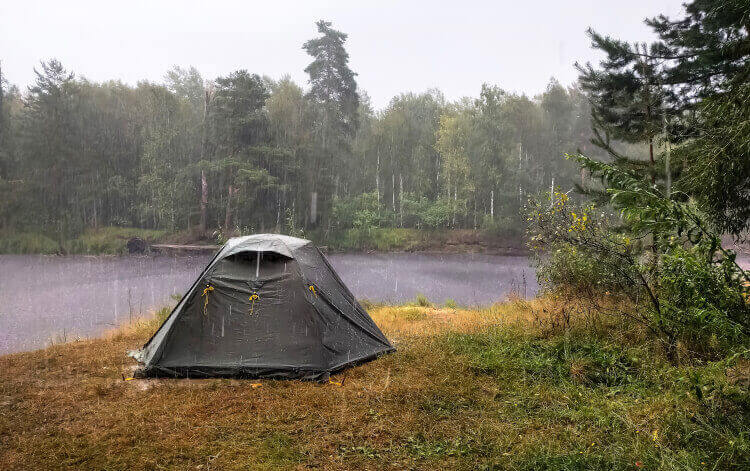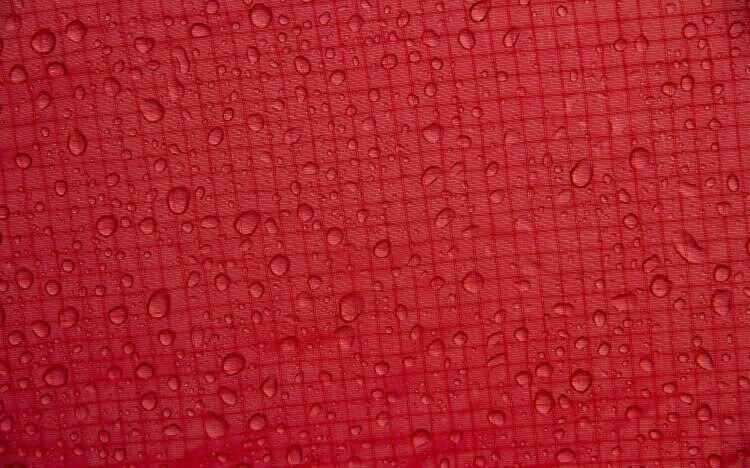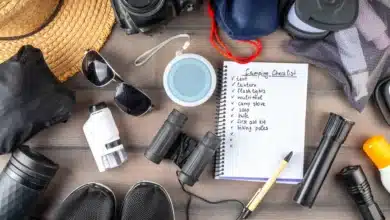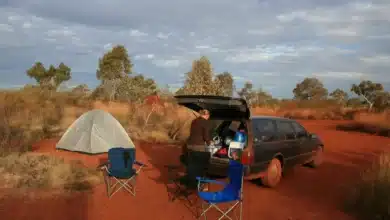Are Tents Waterproof?
If you’re shopping for a new tent, you’ve probably considered buying a tent that is waterproof. But are all tents waterproof? And how can you tell? You may also notice waterproof ratings on tents, which make things more confusing. After all, if you buy a tent you might expect it to be waterproof, right? This article will cover everything you need to know so you can be sure you are buying a real waterproof tent.
Are tents waterproof? No, not all tents are waterproof. Waterproof tents must meet a waterproof rating of 1,000mm HH and above to be considered waterproof. However, tents labeled waterproof may still leak under harsh conditions. Fully waterproof tents may still leak due to poor seam construction or damage to the fabric.
Which Tents Are Waterproof?

Are all tents waterproof? Not exactly. There’s a difference between waterproof and water-resistant. Let’s take a look at the differences.
Water-resistant means a lower level of protection against water. It will keep some water out, but will eventually let water in when it gets too wet. Waterproof, on the other hand, doesn’t let any water penetrate at all.
But when it comes to fabric, it’s quite difficult to be truly 100% waterproof. Most materials will eventually fail to keep water out after enough time and pressure.
Thankfully, there are rating systems to help us understand how well tents will hold up in wet conditions. This is particularly helpful so you can be sure you’re getting the right tent for the job and climate. A tent for letting the kids play in the backyard is going to be much different than a backpacking tent for harsh conditions.
One way to measure waterproofness of a tent is to use hydrostatic head measurements, or HH for short.
You may also like Best Tents with Porch
Waterproof Ratings of Tents

Hydrostatic Head is a rating system used to measure the waterproofing of fabric. It measures how much water the fabric can hold before water starts to penetrate to the other side. A tent rated at 30,000mm HH could hold a column of water 30,000mm high before it starts to leak through the tent.
So, the higher the HH rating the more waterproof the tent? Generally, yes, but it doesn’t tell the whole story. There are other factors to consider besides HH that make your tent waterproof.
One of the biggest sources of leaks in a waterproof rated tent is the seams. A good tent will have doubled stitched seams that are taped over and are sealed. Also, the tent should also be coated with waterproof and UV coatings. In practice, you could have a tent with a high HH rating and still get wet because of its poor construction.
So what’s a good hydrostatic head rating? Well, I put together a handy chart for you.
- 1,000 HH – This is the minimum for the tent to be legally called “waterproof”. In practice, however, 1,000 HH is good for only very light showers.
- 1,500mm – What you would find in a summer tent that can withstand light showers but will start to leak with heavy rainfall.
- 2,000mm – The most common rating you’ll find in three seasons tents that can hold heavy rain and wind.
- 3,000mm – These tents are designed to keep you dry in any condition, including absolute downpours and gale-force winds. These tents are common for high altitude climates.
The higher your HH rating, the better protected you are against rain and water. But keep in mind, it’s still not a bad idea to waterproof your tent as a precaution. For most camping, an HH rating of 2000mm will be just fine. Aim higher if you will be camping regardless of the weather.
Sometimes you’ll also see PU next to the rating. PU stands for Polyurethane. A polyurethane rating means that the fabric was treated with this waterproof coating. Look for a PU rating when you shop for your tent. Opt for a higher rating if you will be in harsh or rainy conditions, or just want max protection.
For instance, a tent with a 1000mm PU rating means it can hold back a column of water measuring 1000mm in height, and 1 inch in diameter before any of it gets inside your tent.Â
Waterproof vs. Non-Waterproof Tents
Waterproof tents are made from breathable but water-resistant fabric like a canvas that has been coated with a PU finish that helps repel moisture. The seals have been treated so that no water will get in. The zippers feature covers, so they don’t get wet and allow water to get through. One good example of a waterproof tent is the Coleman Evanston.
A non-waterproof tent or water-resistant tent like this SEMOO Dome tent are made of polyester and have been treated with PU coating, but still need some extra help to get fully waterproofed using one of the methods we discuss below.
You may also like Best Extreme Weather Tents
What Features To Look For When Buying A Waterproof Tent
Just because a tent is described as “waterproof” doesn’t mean it’s constructed well. Here are things you’ll want to look for when buying a waterproof tent.
- Look for a tent that has a “bathtub floor.” This is a floor made of waterproof material and comes up the sides a few inches before it attaches to the walls of the tent. Verify there are no seams in the floor so that water doesn’t get in.
- Double-wall vs. Single Wall: Double-wall tents have an inner layer that is made of water-resistant nylon, and a rain fly that is waterproof on the outside. Single wall tents have just one layer of water-resistant or waterproof fabric.
- Seams-Verify that seams have been treated with a waterproof sealant so that no water gets in.
You may also like Best Tent Air Conditioners
Best Tent Waterproofing Methods
There are a few ways you can waterproof your tent. We will go over three ways to do just that.
Method 1: Ensuring Rainfly Ties Are Tight
When it comes to the rainfly, we want to make sure ties are tight when they are placed over the tent. Try to do this in a dry setting, as the rain could make your ties sag a bit. One trick is to use reflective cords (see the Aidier cords on Amazon) so that you can see them better if it’s dark out. (After all, you may need to tweak these at some point in the night). You can use a hitch knot to secure the rainfly, as it is an easily adjusted knot.
The advantage of this method is that it is adjustable and can be done anytime during your camping trip. If you need to tighten the cords because a rainstorm just started, you can do it-no need to fumble around for a can of seam sealer or worry about the urethane coating of the tent.
Method 2: Seal The Seams
Most tents you buy come with seams that are sealed up already. However, this sealant can and will wear out as time goes on. Water will eventually come through your tent and cause puddles.
If you come upon a leaky seam, get these supplies together:
- A clean rag
- Seam sealer (Get the right one for your tent. Fabric treated with silicone will require a different sealant than a fabric with polyurethane treatment. The bulk of tents will use polyurethane fabrics, but talk to the manufacturer to be certain).
- A drop cloth
- Rubbing alcohol
Here are steps to seal your seams:
- Go outside on a bright day or in a bright room so all the seams are easily seen. You will seal the seams on the underside and the inner side of your tent’s body.
- Begin by setting up your tent and lay down the drop cloth in case of spills as you work. You might even put the fly inside out so you can get to the seams easier.
- Look at the seam tape. Is it coming loose? Remove the sections that are coming loose and leave any intact parts where they are.
- Once this is done, clean the seams with your clean rag and rubbing alcohol.
- Apply the seam sealer to the seams. If you notice one seam is failing, it is likely that others will follow. Be proactive and apply the sealer to all of the seams.
- Allow it to dry.
You may also like Best Tent Footprint
Method 3: Renew The Urethane Coat
Those of you with older tents, listen up: did you notice some material flaking away from the rainfly or the floor of the tent? It’s time to put on a new urethane coat.
Get these materials first:
- A bottle of rubbing alcohol
- Tent sealant (choose the right one for your tent as we discussed earlier)
- A sponge that has a rough or abrasive side
How to apply a new urethane coat:
- Begin by laying the tent or rainfly flat and use the rubbing alcohol and sponge to get the rest of the urethane coating off.
- Next, apply a thin coat of the new sealant to the entire tent floor or fly. Make sure you follow the instructions on the label, so you apply it correctly.
- Allow the coat to dry for at least 24 hours before putting the tent into storage.
- Afterward, wash your hands thoroughly as the sealant does contain chemicals.
Method 4: Get a Big Blue Tarp

Adding another layer of protection to your tent is going to help immensely. If you’re car camping, what I recommend is getting one of those big blue tarps from Walmart and pitching your tent under it.
This method is a little trickier to do. If you’re in a wide-open field, it’s not going to work since you’ll need to create a ridgeline between to points, like two trees.
What you’ll need for this method is:
- I big tarp (see Amazon price)
- 550 cord for your ridgeline and tie-downs (100 feet is plenty)
- Extra tent stakes (these heavy-duty ones are preferred)
While this does take extra time to set up and tear down, it’s really convenient and will be certain to keep you much drier. It will also offer additional protection against falling branches. The downside to this method is that it could reduce airflow and you won’t get a nice view of the stars.
You may also like Easiest Tents to Set Up by Yourself
Conclusion
So are all tents waterproof? Well, not all of them are. Quality tents will come with a HH or PU rating. An HH or PU rating above 1000 is classified as “waterproof”, but in reality, it may only hold up to light showers so go for a higher rating. Buying a quality tent from a reputable company will last much longer and keep the rain out.
You will need to use a method of waterproofing your tent to truly make it a waterproof structure. For a tent to be waterproofed, you have to ensure it has been coated with polyurethane, and the seams taped so that water can’t seep in. You have to check the zips-quality tents will have a plastic cover to prevent rain from seeping in and sometimes fabric. Check the seams, too-where the tent fabric is joined together. Look on the inside and check for a waterproof coating.
You can also buy yourself a bathtub groundsheet or buy a tent with one sewn in to keep yourself dry. These feature raised sides that prevent water from getting into the tent. Lastly, read the manufacturer’s directions to see if they applied a waterproof coating onto the tent.



